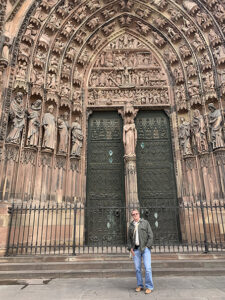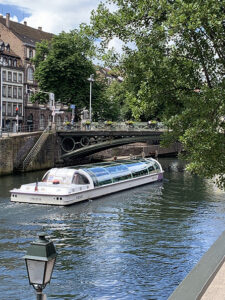STRASBOURG, FRANCE
It was now time for us to continue on our spring vacation to the next destination. We took the local train to Avignon where we would then continue on to Strasbourg. Avignon is always a good place to spend a night. After a great dinner and a good night’s sleep we were ready the next morning to continue. To get to Strasbourg we took the TVG to Lyon airport. The NH Hotel is located across from the terminals and because Lyon, being the gastronomic capital of France, it was imperative we have lunch there and it did not disappoint us. That afternoon we flew to Strasbourg in the northeast part of France on the border of Germany called Alsace.
Strasbourg over the years has changed ownership between Germany and France now a part of France . You can see the German influence in the architecture with the half-timbered houses and in the food, such as pretzels. Also, all the street names are in French with the German name just underneath. We stayed at the Tandem Hotel, an eco-friendly boutique hotel across from the train station. The location was ideal. It was a 5-minute walk to the trains and a 10-minute walk to the center of Strasbourg. There were wonderful restaurants nearby. The hotel has a bar with bio-dynamic wines and a delicious breakfast. You can also rent bicycles at the hotel.
We were ready to explore Strasbourg after reading the literature on the sights of the city and using the map from the hotel. The historic center of Strasbourg is known as the Grande Ȋle (Large Island) as it is surrounded by the canal of the River Ill. We crossed the canal and entered the Grande Ȋle. Our first stop was to visit St. Pierre le Vieux. It is both a Protestant and Catholic church built in the 12th century, showing renaissance paintings and scenes of the life of St. Peter. We continued on until we came to a large plaza, called Place Kléber, the central square of Strasbourg. It is a large open square surrounded by stores and the length of one side is the L’Aubette. This was built in the 18th century, destroyed in 1870 and rebuilt in 1926, designed by three avant-garde artists.  The lower floor is a modern art museum. It once housed soldiers and there is a statue in the center of honoring General Jean-Baptiste Kléber and contains his remains. Our next stop was at Place Gutenberg. In the center is a statue of Johannes Gutenberg with engravings of the history of the printing press around the base. Also in the square is a pretty carousel.
The lower floor is a modern art museum. It once housed soldiers and there is a statue in the center of honoring General Jean-Baptiste Kléber and contains his remains. Our next stop was at Place Gutenberg. In the center is a statue of Johannes Gutenberg with engravings of the history of the printing press around the base. Also in the square is a pretty carousel.
We were headed then to Strasbourg Cathedral. We passed an alley that beckoned us with the sight of an interesting church. We came across a small square dominated by Eglise du Temple Neuf. Originally a Dominican church built in the 13th century it was destroyed and rebuilt in the 20th century. It was quite impressive but also closed. We backtracked and walked to the Strasbourg Cathedral and plaza. Originally it was designated Our Lady of Strasbourg and can be seen from anywhere in the city. Frank was quite impressed by the solid bronze doors. Also towards the back is an astronomical clock. The cathedral was finished being built in 1439 on top of an ancient Roman sanctuary. It began as Catholic and switched to Protestant and then back to Catholic, therefore there is a variety of Romanesque and Gothic architectural styles. The cathedral dominates the square. There are also many surrounding outside cafés. The Tourist Office is also in the square where you can purchase tickets for museums, the Batorama boat ride and the Mini Train Tour. Opposite we saw the Palais Rohan. This palace was built in the 18th century and now houses three museums. It started to rain and so we skipped this visit in search of a café to wait for the rain to pass.
We had one more area to visit and that was Petite France. There are four canals here, some with locks. As we strolled along the canals, we watched the Batorama tourist boats pass through the locks. The half-timbered buildings along the canals were picturesque. We stopped for lunch in Tanner’s Quarter. It is called the Tanner’s quarter because in the 16th century it housed tanners and millers. After lunch we strolled along the canals sightseeing and shopping, then stopped at one of the many peaceful outside cafés along the canal to enjoy the surroundings. The entrance to the city was guarded by four towers connected by covered bridges over the River Ill. We walked over to the Vauban Dam and climbed the stairs for a panoramic view. It was a relaxing afternoon in Petit France. That night we ate dinner at Le Schnockelock for the Alsace specialty done the old-fashioned way, choucroute ( a dish prepared with sauerkraut, sausages, other meats and often potatoes), and savored with a glass of Riesling. The restaurant had that old-fashioned ambiance. The food was delicious, and everyone seated next to us agreed that it was too much food, but we all had some good laughs about it.





